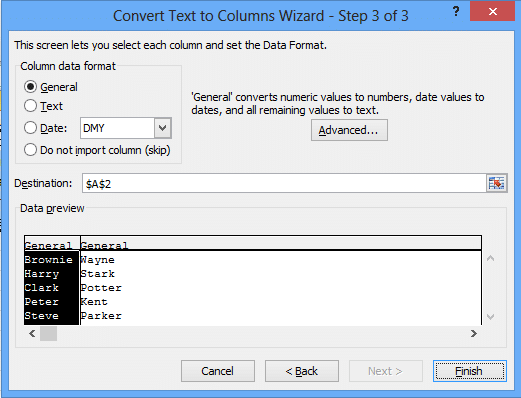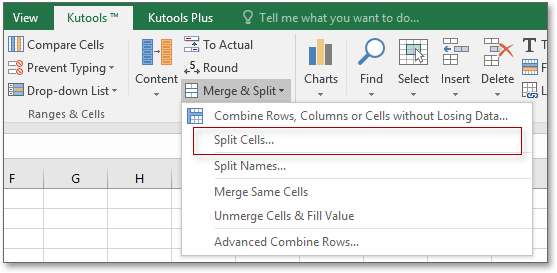To split a cell in Excel, add a new column, change the column widths and merge cells. To split the contents of a cell into multiple cells, use the Text to Columns wizard, flash fill or formulas. Splitting cells also provide better sorting and filtering of an existing table. In excel, there are many ways to split cells. Some of the processes are Unmerge cells, Flash Fill, and Text to Column feature. You can also use formulas or VBA code to split cells. In this article, we will see the different processes on how to split cells in excel. Split cells Click in a cell, or select multiple cells that you want to split. Under Table Tools, on the Layout tab, in the Merge group, click Split Cells. Enter the number of columns or rows that you want to split the selected cells into. Select the cell you want to split. You can select multiple cells at the same time if you wish. Select the Data tab and choose the “Text to Columns” option. Choose “Delimited” if prompted. Select the type of delimiter (s) your cell uses. Use the preview pane to see if your cell’s data is splitting correctly.
How to split a cell diagonally in Excel?
It’s common to split cell content by space, comma, etc. in Excel. But do you know how to split a cell diagonally as below screenshot shown? This article will show you the solution.
Split a cell diagonally in Excel
Split a cell diagonally in Excel
To split a single cell diagonally in Excel, please do as follows:
1. Right-click the specified cell you will split diagonally, and select Format Cells from the context menu. See screenshot:
2. In the Format Cells dialog box, please click to enable the Border tab, click to highlight button in the Border section, and then click the OK button. See screenshot:
Now the diagonal line is added in the specified cell. See screenshot:
3. Please type the two words in the specified cell as you need. Then highlight the first word in the cell, and click the Arrow at the bottom-right corner of the Font group on the Home tab. See screenshot:
4. In the popping out Format Cells dialog box, please check the Superscript option, and click the OK button. See screenshot:
5. Please repeat above Step 3-4 to format the second word as a subscript.
Now you will see the two words in the specified cell is split diagonally. See screenshot:
Demo: Split a cell diagonally in Excel
Kutools for Excel includes more than 300 handy tools for Excel, free to try without limitation in 30 days. Free Trial Now!Buy Now!
Batch Separate text and numbers from one cell/column into different columns/rows
Kutools for Excel enhances its Split Cells utility and supports to batch separate all text characters and numbers of one cell/column into two columns/rows. Full Feature Free Trial 30-day!
Related articles:
The Best Office Productivity Tools
Kutools for Excel Solves Most of Your Problems, and Increases Your Productivity by 80%

- Reuse: Quickly insert complex formulas, charts and anything that you have used before; Encrypt Cells with password; Create Mailing List and send emails...
- Super Formula Bar (easily edit multiple lines of text and formula); Reading Layout (easily read and edit large numbers of cells); Paste to Filtered Range...
- Merge Cells/Rows/Columns without losing Data; Split Cells Content; Combine Duplicate Rows/Columns... Prevent Duplicate Cells; Compare Ranges...
- Select Duplicate or Unique Rows; Select Blank Rows (all cells are empty); Super Find and Fuzzy Find in Many Workbooks; Random Select...
- Exact Copy Multiple Cells without changing formula reference; Auto Create References to Multiple Sheets; Insert Bullets, Check Boxes and more...
- Extract Text, Add Text, Remove by Position, Remove Space; Create and Print Paging Subtotals; Convert Between Cells Content and Comments...
- Super Filter (save and apply filter schemes to other sheets); Advanced Sort by month/week/day, frequency and more; Special Filter by bold, italic...
- Combine Workbooks and WorkSheets; Merge Tables based on key columns; Split Data into Multiple Sheets; Batch Convert xls, xlsx and PDF...
- More than 300 powerful features. Supports Office/Excel 2007-2019 and 365. Supports all languages. Easy deploying in your enterprise or organization. Full features 30-day free trial. 60-day money back guarantee.
Office Tab Brings Tabbed interface to Office, and Make Your Work Much Easier
- Enable tabbed editing and reading in Word, Excel, PowerPoint, Publisher, Access, Visio and Project.
- Open and create multiple documents in new tabs of the same window, rather than in new windows.
- Increases your productivity by 50%, and reduces hundreds of mouse clicks for you every day!
or post as a guest, but your post won't be published automatically.

- To post as a guest, your comment is unpublished.Thanks for the help
Comfortable and satisfying as it is, working with Excel can sometimes be confusing. There sure have been times when you entered a lot of data in single cells under a column and decided later that all the information in those single cells better be divided into different cells under multiple columns. At times like this, you need to know how to split cells in Excel!
In this tutorial, we are going to explain three methods to split cells in Excel.
Splitting Cells Using Text to Column Feature
Suppose that you have a spreadsheet containing some information about a group of people, including first name, last name, and ID number and you want to put this information in separate cells.
You can split these data following these steps:
- Select the cells you want to split the data.
- Go to the Data tab and choose “Text to Column” from the Data Tools group.
3. The “Convert text to column wizard” window will open. This part includes three steps:
- Step 1 of 3: At this step, you have 2 options: Delimited and Fixed Width. Choose the “Delimited” option, which is the character by which you specify to split cells and then click Next.
- Step 2 of 3: Since our data are separated by space and comma, you must choose both as delimiters and then click Next. Also, you’d better check the “Treat consecutive delimiters as one” box. You can see the result in the Data preview section.
- Step 3of 3: At this stage, you can specify the data format and the data destination. Leave the data format as General. Change the destination to $B$2 by typing it or clicking on the icon and selecting a range on the spreadsheet. Having set the information, click Finish.
And here’s the result.
Note: If you leave the destination as default, Excel will keep the first column where it is and move the rest to the next columns.
Splitting Cells Using the Flash Fill Feature
Another easy way to split cells in Excel is using the flash fill option. To split cells in the previous example, we just need to write the part of the text that we want splitted in the desired cell, then use the flash fill feature.
Suppose that you want to extract the first names, last names, and ID numbers from the first column and put them in the next columns. All you need to do is to follow these steps:
- In Cell B2, type the corresponding first name (i.e., Matilda).
- Press “Ctrl+E,” which is the shortcut for the flash fill option.
- Do the same thing for the last names and ID numbers.
Note: If you don’t want to use shortcuts, you can go to the Data tab and click on Flash Fill from the Data Tools group.
Splitting Cells Using Text Functions
The last method to split cells is using Excel text functions. Excel text functions work great when you want to split cells. You must know how to use these functions and how to combine them.
Here are the text functions that we can use to split cells in Excel:
- LEFT: It extracts a specific number of characters from the left side of a string
- FIND: We use it to find a string inside another one. It returns the starting position of the sub-string as a number.
- RIGHT: It extracts a specific number of characters from the right side of a string.
- LEN: It returns the total number of characters in a text string.
- MID: It extracts a substring from a text string. It returns the number of characters starting from the position you specify.
- SUBSTITUTE: It replaces one or more text strings with another one.
Note: Excel SEARCH function does the same thing as the FIND function. The only difference is that the FIND function is case-sensitive, but the SEARCH function is not.
Now that we know the text functions we need, we can directly go to the examples.
Extracting the First Name
This example shows how to extract the first names from a list containing first names and last names.
To extract the first names, we can use the combination of the LEFT function and the FIND function. To do so, we use the following formula:
=LEFT(A2,FIND(' ',A2))
In this formula, the FIND function finds the space character’s location as a number and gives it to the LEFT function to split the first name from cell A2.
Note: This formula works for the previous example too.
Extracting the Last Name
To extract the last names, we use a combination of the RIGHT, FIND, and LEN functions. To do so, we use the formula below:
=RIGHT(A2,LEN(A2)-FIND(' ',A2))
This formula locates the space character and splits the characters after it.
If our list includes middle names, we have to combine the above functions with IF and SUBSTITUTE functions. Look at the formula below:
=IF(LEN(A2)-LEN(SUBSTITUTE(A2,' ','))=1,RIGHT(A2,LEN(A2)-FIND(' ',A2)),RIGHT(A2,LEN(A2)-FIND(' ',A2,FIND(' ',A2)+1)))
In this formula, the IF function checks the existence of a middle name. The formula counts the number of the space characters; if there is only one, it uses the exact formula we introduced for extracting the last name before; if there are two spaces, it locates the second one and splits the next characters.
Now, what if we had the first example’s data and wanted to extract the last names? The answer is the combination of the MID and FIND functions as below:
=MID(A2,FIND(' ',A2)+1,FIND(',',A2)-FIND(' ',A2)-1)
Extracting the Middle Name
Sometimes, you have a list of names that include middle names, like the second example about the last names. To extract the middle name from a text, we combine the MID and SEARCH functions. Look at the following formula:
=MID(A2,SEARCH(' ',A2)+1,SEARCH(' ',A2,SEARCH(' ',A2)+1)-SEARCH(' ',A2))
In this formula, the MID function extracts the characters between the two spaces.
Note: If you enter the above formula for a text without a middle name, it returns the #VALUE error. To avoid this, you can use the IFERROR function. Look at the formula below:
=IFERROR(MID(A5,FIND(' ',A5)+1,FIND(' ',A5,FIND(' ',A5)+1)-FIND(' ',A5)),'-')
Here, the text in cell A5 does not have a middle name, so the formula returns the “-” character. It’s obvious that if we use it for cell A2, it will give the middle name.
We have covered three simple methods to split cells in Excel. Now, you have a choice, so see which one you are more comfortable with and try that one out.
You can connect with us and ask our experts for your inquiries and get more Excel Support Service.
Excel For Mac Split Cells Without
Reduce cost, accelerate tasks, and improve quality with Excel Automation Service.